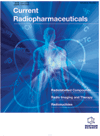-
oa Editorial [Hot topic: (Part I) Focus on [18F]fluoride Radiochemistry (Guest Editors: D. Roeda, M. Kassiou and F. Dolle)]
- Source: Current Radiopharmaceuticals, Volume 3, Issue 2, Apr 2010, p. 66 - 67
-
- 01 Apr 2010
- Previous Article
- Table of Contents
- Next Article
Abstract
Nowadays it is becoming increasingly commonplace for a physician to prescribe an FDG-PET scan, especially in oncology. FDG, short for 2-[18F]fluoro-2-deoxy-D-glucose, is a radioactive derivative of D-glucose that accumulates in tissue according to their degree of D-glucose utilization and is therefore very suitable to detect tumours and evaluate their metabolic state. The radiosynthesis of FDG was achieved for the first time in 1978 but it has been only in the last decade that its routine use in nuclear medicine has really taken on. The reason for this relatively long incubation time is twofold. It takes a certain time for a radiopharmaceutical to prove itself and to convince the medical profession of its utility. In addition there were technical and logistic problems to be solved. How to produce FDG regularly in sufficient quantities at a sufficient number of sites? A key factor in all this is radiochemistry know-how, which has seen considerable progress with time. For example, in the beginning FDG was made in relatively low yield with electrophilic [18F]F2 when today's efficient nucleophilic method with [18F]F- was not available. Indeed, the advent of a reliable method that renders cyclotron-produced aqueous and chemically unreactive [18F]fluoride suitable for nucleophilic substitution reactions has revolutionized radiopharmaceutical development with fluorine- 18. It is therefore not a co-incidence that all eleven contributions to the present “focus on [18F]fluoride radiochemistry”, covered by two successive issues of the journal, deal almost exclusively with nucleophilic radiofluorination. The present first issue (volume 3, number 2) begins with a concise outline of the field by Banister et al., the ideas of which are then developed more in depth in the following contributions. Introduction of fluoride in an aromatic position is less straightforward than aliphatic fluorination, the latter treated by Roeda and Dolle, and its methodology is accordingly more differentiated. This is reviewed in separate contributions by Ermert and Coenen, dealing successively with direct labelling at an activated position and built-up syntheses via small radiofluorinated synthons. The second issue (volume 3, number 3) will open with the third contribution by Ermert and Coenen, this time on the labelling of electron-rich arenes, completing the initial expose of the state of the art. Then Kuhnast and Dolle will look at the more specific field of macromolecule labelling which is rapidly gaining importance. Especially within this field of macromolecules two developments have recently attracted attention, both directed towards prosthetic group construction. The first is the copper(I)-catalyzed Huisgen coupling between a terminal alkyne and an azide, either labelled with fluorine-18, to give a triazole. This reaction, also known under the name “click chemistry” will be reviewed by Ross, followed by an article by Mu et al. on radiochemistry based on fluorine-silicon and fluorine-boron bond formation involving structures of the type RSi[18F]F4 -,R'R2Si[18F]F and RB[18F]F3. Then Martarello et al. will describe the recently discovered enzyme that can (radio)fluorinate adenosine giving access to various sugar- and nucleoside-like structures by coupled enzyme reactions. Our compilation will conclude with two contributions on technological developments. Sachinidis et al. give their view on the basic principles of automation, so important for safe and reliable routine production of radiopharmaceuticals while Miller at al take us to the fascinating world of extremely small reaction volumes in microfluidic technology that is not unlikely to have a big future in PET chemistry. It is clear that fluorine-18 radiochemistry has reached a certain degree of maturity and continues to strive after perfection and innovation, hopefully leading to new and useful radiopharmaceuticals as successful as FDG.


